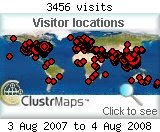Read on...
AN ISLAND SLAKES ITS THIRST
by EDWIN GENERAL
KAHIKUKUK, BANGUIGUI, SULU — Asaali Muhalli is no ancient mariner, but there was a time when his lament was practically an echo of that of the protagonist in Samuel Taylor Coleridge’s famous poem: “Water, water everywhere, and not a drop to drink.”
Muhalli, a 40-something schoolteacher, has lived in this remote village since birth. He recalls, “I lived on an island surrounded by water, yet ironically, our life was without drinking water.”
But for the last two years, Muhalli and the rest of the residents here have had no reason to sigh — at least not over the lack of potable water. In September 2006, Kahikukuk became the beneficiary of a solar-powered system to supply drinkable water to the entire village, and life here has not been the same since. For one, says Muhalli, water-borne diseases are no longer as common as before. For another, villagers have stopped digging just about anywhere they could think of in their desperation to tap an underground water source.
Muhalli says that one of his neighbors began digging a hole in his own backyard, hoping to strike water. Instead, the neighbor unearthed a pile of human skeletons. According to Muhalli, his neighbor decided to transfer house posthaste.
 Location map of Banguigui (formerly Tongkil), Sulu courtesy of Wikipedia | |
It’s no wonder then that the government itself has cautiously predicted that the country has a “medium” chance of achieving the target of halving the proportion of the Philippine population without sustainable access to safe drinking water by 2015. The target falls under the Millennium Development Goal (MDG) of Environment Sustainability that the Philippines is committed to meeting seven years from now. Numbering eight in all, the MDGs, which range from education to health, to food security, are part of a global initiative to combat poverty.
The initiative stresses the cooperation of aid agencies, national governments, and the private sector in the effort. Indeed, Kahikukuk may not have gotten its rather unique water system had such cooperation been absent. Banguingui Mayor Hadji Wahid Sahidulla himself says that with his local government’s meager budget, “we cannot afford to develop such a project, considering the many immediate needs (of) our constituents.”
LOCATED ABOUT five hours away from Zamboanga City by motorboat, Kahikukuk is part of the Tongkil group of islands in Sulu. It is home to some 30,000 Samal-Banguigui natives who depend largely on fishing and seaweed farming for their livelihood. Some families also operate motorboats that ferry people to nearby islands, but even then many households here often can afford to have only two meals per day.
Kahikukuk’s story illustrates how the lack of access to potable water can make an already poor community even more impoverished. Children suffering from water-borne illnesses like cholera and diarrhea, for example, lost days — sometimes weeks — of school, while similarly stricken adults were unable to work.
 SOLAR-powered water system in Kahikukuk. [photo courtesy of AMORE] | |
A father of two boys, Muhalli adds that his family’s paltry household budget shrank even more each time they bought water that was brought in from neighboring Basilan. Peddlers sold each 20-gallon container for P25; normally, says Muhalli, one household would consume some 10 containers each day.
The alternative was to fetch water from either any of the makeshift deep wells that still dot the island or the main water source that was about an hour’s walk from the village. That source, a very deep open well located near the foot of a hill, is adjacent to a muddy area where cows like to wallow.
During the rainy season, the well would overflow and the surrounding field would be flooded. The result was water that was murky with soil and animal dung. But the water did not necessarily clear up whenever the sun was out.
“I could waste a whole day just to fill two containers and even then the water was brown,” says Ernilisa Jurail, a 28-year-old mother of four, recalling her long treks to fetch water for her family. “I also had nothing clean to wear. I washed my clothes and took a bath only once a week.”
The backyard wells were no better, perhaps because many families also maintained their latrines in the same area. Experts point out that even professionally built tube wells are easily contaminated when these are located less than 30 meters away from animal ditches, latrines, stagnant waters, garbage, and poor drainages.
Many of the families thus tried to save rainwater in huge drums and jars. But they had a hard time keeping this free from mosquito larvae, says Muhalli, and so they would try to filter the water through cloth and boil it before drinking it. He also recalls how some women and children would brave going to Abu Sayyaf-infested Basilan just to get potable water.WHITHER THE MDGs?
MDGS? WHAT MDGs?
 THE ambulant and transient poor are excluded from official poverty estimation. [photo by Jaileen Jimeno] | |
In its progress report on the MDGs that it launched last October, the Philippine government said there may be trouble ahead regarding targets for achieving universal primary education (goal number 2), as well as those on improving maternal health (goal five), specifically improving the maternal mortality ratio and increasing access to reproductive health services. But it also said that there was a high probability of meeting most of the other targets for the rest of the goals, which are: eradicating extreme poverty and hunger (goal 1); promoting gender equality and empowering women (goal 2); reducing child mortality (goal 4); combating HIV/AIDS, malaria, and other diseases (goal 6); ensuring environmental sustainability (goal 7); and developing a global partnership for development (goal 8).
Even in October, the Philippine midterm progress report made economists and development experts blink and purse their lips. Today, just a few months later, the furrows on their brows have also deepened.
On January 31, 2008 the National Statistical Coordination Board (NSCB) reported an increase of 7.3 percent in the GDP for 2007. Less than two months later, the NSCB said that poverty had worsened between 2003 and 2006. During the recently concluded Philippine Development Forum, representatives of donor institutions and countries asked repeatedly: “How come there is rising poverty and hunger in the midst of growth?”
Before the statistics on worsening poverty broke out, rosy projections about the future and the MDGs were also threatened with fears about a looming U.S. recession and increases in the price of oil. These developments cannot help but have a profound impact on the attainment of the MDGs by 2015.
TO BE fair, the high probability of attaining most of the targets hold true for national figures. But the picture changes dramatically when data are broken down to the local level. The wide disparities among regions, provinces, and municipalities are vast and seemingly insurmountable. The Philippine midterm report itself recognized the yawning gaps across regions. Among the challenges it identified were the high population growth rate, the low performance of the agricultural sector, the weak implementation of basic education and health reforms, and lax enforcement of laws. It also noted the problems with the financing gap, the capacity of local governments, transparency and accountability, peace and security issues, public-private partnerships, and targeting, database, and monitoring.
But perhaps what has to be scrutinized first is the mystery of worsening poverty amid supposed economic growth. After all, eradicating poverty is Goal No. 1, with its more specific targets being to reduce by half the proportion of people living on less than a dollar a day, as well as those suffering from hunger. The level of success in achieving this goal has a profound impact on the rest of the MDGs.
Yet no less than government statistics confirm the worsening of poverty. The twin threats of a looming rice crisis and global warming also do not warrant the happy prediction of a high probability of meeting the goal in nutrition — and especially not when surveys of the Social Weather Stations reflect persistent high levels of hunger, particularly in the National Capital Region (NCR) and in the Autonomous Region of Muslim Mindanao (ARMM).
In 2003, the government counted four million families as poor. By 2006, that figure had gone up to 4.7 million. This translates to 27.6 million wretched souls. The poverty threshold for the same year went up from P12,309 per capita annual income to P15,057.
Even worse, the number of the subsistence poor or absolutely poor has been rising. There are now 11 million families or 14.6 million individuals who belong to this category.
To quote the NSCB, “In terms of poverty incidence among population, out of 100 Filipinos, 33 were poor in 2006, compared to 30 in 2003.” This means a full third of the population! No wonder even the usually sedate and diplomatic representatives of foreign institutions and donor countries expressed utmost concern and repeatedly raised the issue during the Philippine Development Forum.
Here are more depressing statistics: In 2003, official figures indicated that 56.9 percent of households have per capita intake below the 100 percent dietary requirement. Given the other economic data, it is likely that proportion has become bigger. In more pedestrian terms, more than half of households are not getting adequate nutrition.
Yet the government keeps on saying that the country is experiencing unprecedented economic growth.
What officials may be refusing to see is that growth can only be meaningful if it results in increased incomes, more jobs, and stable prices for the man on the street. Among the initial questions that should be asked then are: Where is the growth coming from? Who are the main beneficiaries? These are crucial queries because the state of the economy cannot be separated from the state of social development, particularly the MDGs. Like the MDG numbers, while the national totals look good, they raise worries when disaggregated.














0 comments:
Post a Comment